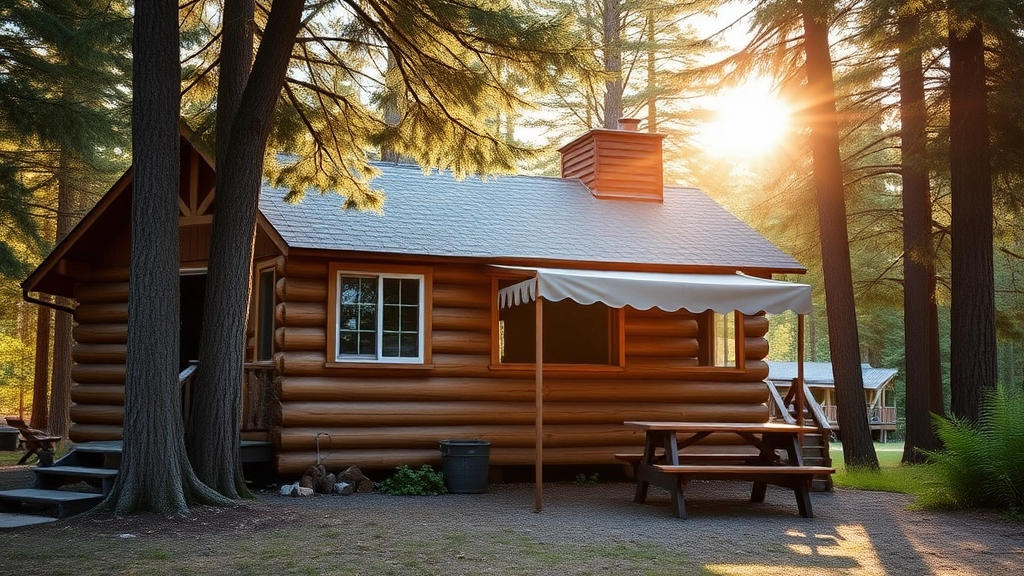Embarking on the Journey
Embarking on the journey to find the perfect summer camp cabin can be both exciting and overwhelming. From classic log cabins to modern prefab designs, the choices are vast and varied. This article delves into the different types of summer camp cabins, highlighting their unique features, materials, and amenities. Whether you’re looking for rustic charm or contemporary efficiency, we cover it all to help you make an informed decision.
Exploring Essential Aspects
But it doesn’t stop there. We’ll also explore essential safety standards, budget considerations, and seasonal maintenance tips to ensure your cabins remain safe and comfortable year-round. Through real-life case studies and practical advice, you’ll gain insights into creating the ultimate camp experience.
Ready to Elevate Your Cabin Experience?
So, if you’re ready to elevate your summer camp cabin stock, let’s dive in and discover what makes a cabin truly exceptional.
Types of Summer Camp Cabins
Ever wondered what makes a summer camp cabin the right fit for you? Let’s dive into the types of cabins you might come across and why they matter. You want comfort, safety, and a bit of fun, right? Let’s break it down.
Traditional Log Cabins
These are the classic, rustic cabins you picture when thinking about summer camps. Built from logs, they offer a natural, cosy vibe. They’re perfect if you’re aiming for that authentic camp feel. But remember, they might not have all the modern amenities.
Pros:
- Authentic look and feel
- Natural insulation
- Durable and long-lasting
Cons:
- May lack modern amenities
- Can be more expensive to maintain
Modern Prefab Cabins
If you’re looking for something sleek and efficient, prefab cabins are your go-to. They’re built off-site and assembled on location, which saves time and can be more cost-effective.
Pros:
- Quick to set up
- Cost-effective
- Often energy-efficient
Cons:
- Less customisable
- Can look less traditional
Canvas Tents and Yurts
Want a bit of adventure? Canvas tents and yurts offer a unique camping experience. They’re less of a cabin and more of an experience, great for short-term stays and those seeking something different.
Pros:
- Unique and adventurous
- Quick to set up and take down
- Often more affordable
Cons:
- Less durable
- Limited amenities
A-Frame Cabins
These cabins are all about style and simplicity. The A-frame design is both charming and functional, providing good insulation and a spacious interior.
Pros:
- Stylish and modern
- Good insulation
- Efficient use of space
Cons:
- Limited design options
- Can be tricky to furnish
Bunkhouse Cabins
For those camps that host groups, bunkhouse cabins are ideal. They’re designed to house multiple people, making them perfect for team activities and bonding.
Pros:
- Great for groups
- Encourages social interaction
- Cost-effective for large numbers
Cons:
- Less privacy
- Can be noisy
For more tips on ensuring your cabin is safe and functional, check out our guide on summer camp cabin safety and design tips. Additionally, if you’re curious about the broader summer camp culture, don’t miss our article on summer camp traditions and activities.
Key Features of High-Quality Camp Cabins
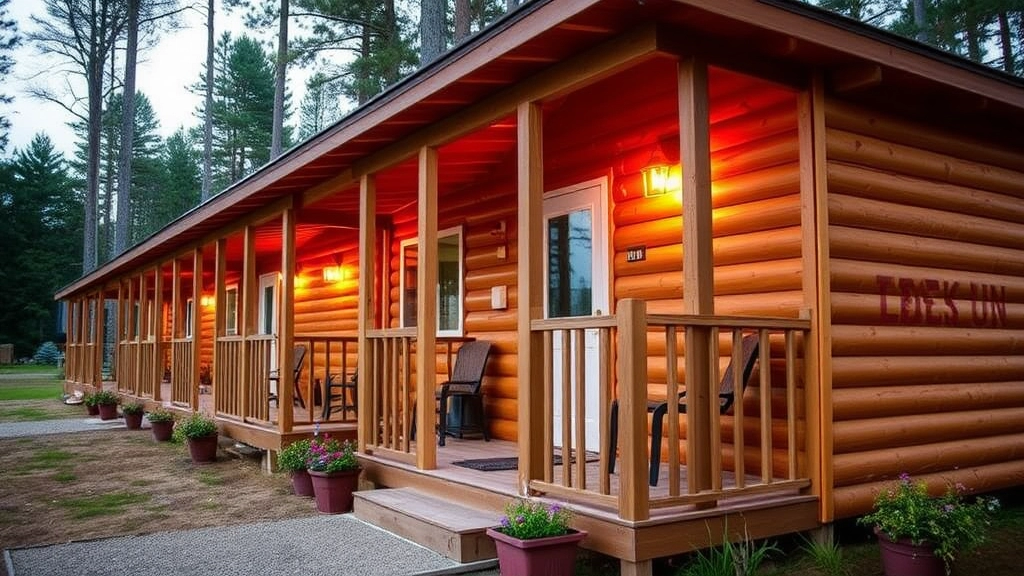
Ever wondered what makes a camp cabin top-notch?
Let’s dive right in:
Durability and Strength
First off, a high-quality camp cabin needs to be built to last. No one wants to worry about the roof caving in during a summer storm. So, look for cabins made from sturdy materials like pressure-treated wood or metal roofing. These materials can take a beating from the elements and still stand strong.
Comfort is King
Next up, comfort. Because who wants to rough it more than necessary?
- Insulation: Keeps the cabin warm in the chilly nights and cool during the hot days.
- Ventilation: Good airflow is a must. Think ceiling fans, windows that open, and maybe even a skylight.
- Bedding: Comfortable mattresses and clean linens. No one enjoys sleeping on a rock-hard bed.
Safety First
Safety isn’t just a buzzword; it’s a must-have.
- Smoke detectors: An absolute non-negotiable.
- Fire extinguishers: Easily accessible and regularly checked.
- Sturdy construction: No loose floorboards or shaky railings.
Functionality and Space
A great cabin is functional and makes the best use of space.
- Storage: Plenty of it. Think under-bed storage, hooks for hanging clothes, and shelves for personal items.
- Layout: A smart layout makes a small space feel bigger. Separate areas for sleeping, dressing, and lounging are ideal.
- Utilities: Running water, electricity, and maybe even a small kitchenette.
Aesthetic Appeal
Let’s not forget about looks. A cabin should feel like a home away from home.
- Natural light: Big windows or glass doors to let the sunshine in.
- Decor: Simple but charming. Think rustic furniture, cosy rugs, and maybe a few nature-themed artworks.
- Exterior: A well-maintained exterior with a nice porch or deck can make all the difference.
Real Examples
Remember that one camp you went to where the cabins felt like tiny homes?
They had everything: comfy beds, plenty of storage, and even a small porch where you could sip your morning coffee.
That’s the gold standard.
Internal Links
Curious about different cabin designs? Check out Popular Summer Camp Cabin Designs.
Wondering what materials to choose? Dive into Materials Used in Building Camp Cabins.
Popular Summer Camp Cabin Designs
Alright, let’s dive into what really matters when it comes to summer camp cabins: the designs. You’re probably wondering, “What are the most popular designs out there?” Well, let me break it down for you.
The Classic Log Cabin
First up, we have the classic log cabin. This one’s a favourite for a reason. It’s got that rustic charm that screams “summer camp.” Plus, it’s durable and can withstand all kinds of weather. Here’s why people love it:
- Timeless Appeal: You can’t go wrong with a design that’s been around for centuries.
- Natural Insulation: Logs are great insulators, keeping the cabin warm in the winter and cool in the summer.
- Aesthetic: Let’s face it, log cabins just look cool.
The Modern Minimalist Cabin
Next on the list is the modern minimalist cabin. This design is sleek, simple, and perfect for those who prefer a more contemporary look. Think clean lines, large windows, and open spaces.
- Efficient Use of Space: Every square foot is utilised effectively.
- Eco-Friendly: Often built with sustainable materials.
- Low Maintenance: Less is more, especially when it comes to upkeep.
The A-Frame Cabin
The A-frame cabin is another popular choice. Its triangular shape makes it stand out, and it’s incredibly sturdy.
- Unique Design: The A-frame is eye-catching and offers a lot of character.
- Easy Construction: Its simple structure makes it easier to build.
- Great for Snowy Areas: The steep roof prevents snow build-up.
The Bunkhouse Cabin
If you’re running a camp that hosts a lot of kids, the bunkhouse cabin is a must-have. It’s all about maximising space and fostering a sense of community.
- High Capacity: Can accommodate a large number of campers.
- Social Environment: Encourages bonding and teamwork.
- Cost-Effective: More bang for your buck.
The Treehouse Cabin
Last but not least, let’s talk about the treehouse cabin. This one’s for the adventurous souls out there. Imagine waking up to the sound of birds chirping right outside your window.
- Unique Experience: Offers a one-of-a-kind stay.
- Immersive Nature: You’re literally surrounded by trees.
- Kid Magnet: Kids (and adults) love the novelty of staying in a treehouse.
Why Design Matters
Choosing the right design isn’t just about aesthetics. It’s about creating an environment that enhances the camp experience. A well-designed cabin can:
- Boost Camper Morale: A cool cabin can make the camp experience more enjoyable.
- Increase Safety: Certain designs are more secure and weather-resistant.
- Save Money: Efficient designs can reduce maintenance and energy costs.
Real Stories, Real Impact
Let me share a quick story. A friend of mine runs a summer camp and decided to go with A-frame cabins. Initially, he was sceptical about the design, but once they were up, the feedback was phenomenal. Kids loved the unique shape, and the cabins held up great during a particularly harsh winter. His camp saw a 20% increase in enrolment the following year, all thanks to the new cabins.
So, there you have it. Popular summer camp cabin designs that not only look good but also serve a purpose. Whether you’re into the classic log cabin or the modern minimalist look, there’s something out there for everyone.
For more tips on creating the perfect summer camp environment, check out our cabin safety and design tips and learn how to build a summer camp wooden arch to enhance your camp’s aesthetic and functionality.
What’s your favourite cabin design and why? Drop a comment below; I’d love to hear your thoughts!
Remember, the right design can make or break your camp experience. Choose wisely!
Materials Used in Building Camp Cabins
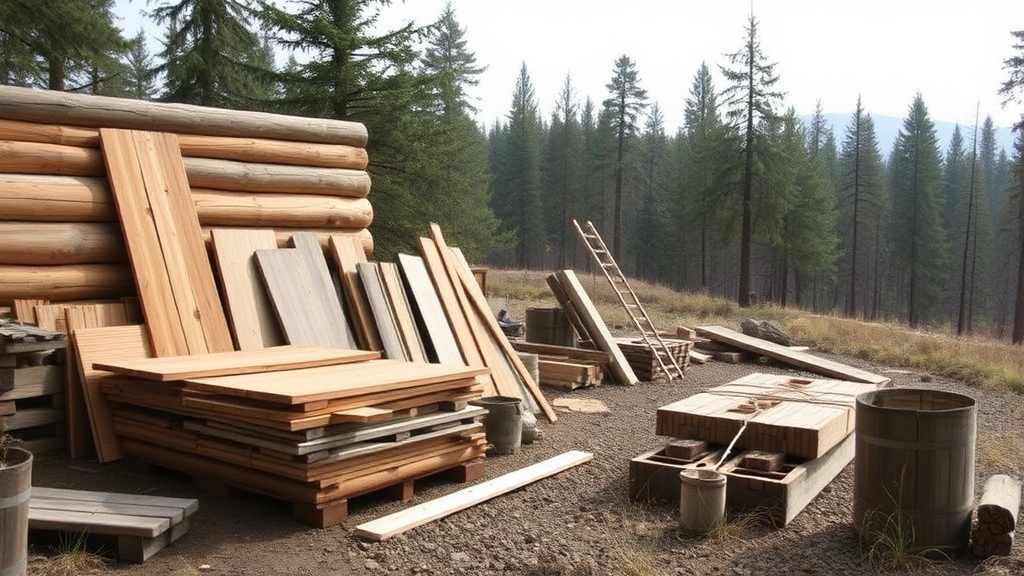
Alright, let’s talk about something crucial—materials used in building camp cabins.
Ever wondered why some cabins feel like a home away from home while others are just meh?
The materials make all the difference.
Why Materials Matter
First off, the right materials can make or break your summer camp experience.
Imagine staying in a cabin that’s too hot in summer or too cold at night.
Not fun, right?
Common Materials Used
Here’s a quick rundown of what’s often used:
- Wood: The classic choice. It’s cosy, breathable, and gives that rustic feel. Plus, it’s great for insulation.
- Metal: Durable and low-maintenance. Ideal for cabins that need to withstand harsh weather.
- Composite Materials: Think of it as a mix of wood and plastic. It’s strong, weather-resistant, and often eco-friendly.
- Concrete: Solid and fire-resistant. Perfect for permanent structures but can feel a bit cold without proper insulation.
Pros and Cons
Let’s break it down:
Wood:
- Pros: Insulates well, aesthetically pleasing
- Cons: Needs regular maintenance, can be prone to pests
Metal:
- Pros: Long-lasting, low upkeep
- Cons: Can be noisy, might need extra insulation
Composite Materials:
- Pros: Durable, minimal maintenance
- Cons: Can be pricey, limited design options
Concrete:
- Pros: Fire-resistant, durable
- Cons: Expensive, can feel cold
Real Stories
I once visited a camp with wooden cabins. The smell of pine, the warmth—it was like stepping into a fairy tale.
But they had to deal with termites.
On the flip side, a friend stayed in a metal cabin during a storm.
Sounded like a drum solo all night.
What to Consider
When choosing materials, think about:
- Climate: Is it hot, cold, or rainy most of the year?
- Budget: How much are you willing to spend upfront vs. maintenance costs?
- Longevity: How long do you need these cabins to last?
- Aesthetics: What vibe are you going for?
Essential Amenities for Comfortable Cabin Stays
Alright, let’s get real. You’re heading to a summer camp, but you still want some level of comfort, right? You’re probably wondering, “What should my cabin have to make my stay enjoyable?” Trust me, I’ve been there. Here’s the lowdown on what makes a cabin not just bearable, but downright enjoyable.
Must-Have Amenities for a Comfortable Stay
1. Comfortable Bedding
- Mattresses: A good night’s sleep is non-negotiable. Make sure the mattresses are decent. No one wants to sleep on a rock-hard bed.
- Pillows and Linens: Clean, soft pillows and linens make a world of difference.
2. Climate Control
- Air Conditioning/Heating: Depending on the season, you’ll need either a good AC or a reliable heater. Sweltering in summer or freezing in winter is a no-go.
- Ventilation: Proper airflow is key. Windows that open and close easily can make a cabin feel much more comfortable.
3. Clean and Functional Bathrooms
- Showers: Hot water is a must. A cold shower might be refreshing once, but not for your entire stay.
- Toilets: Clean, well-maintained toilets are essential. No one wants to deal with a clogged or dirty loo.
4. Storage Space
- Closets and Shelves: You need somewhere to stash your gear. Clutter can turn a cozy cabin into a chaotic mess.
- Hooks and Hangers: These small additions can make a big difference in keeping your space tidy.
5. Lighting
- Natural Light: Big windows can brighten up the cabin and improve your mood.
- Artificial Lighting: Lamps and overhead lights should be functional and ideally adjustable.
6. Electrical Outlets
- Plenty of Outlets: Charging your phone, camera, or other gadgets is crucial. Make sure there are enough outlets for everyone.
- Power Strips: These can be a lifesaver if outlets are scarce.
7. Seating Area
- Comfortable Chairs: A small seating area with comfortable chairs or even a sofa can make the cabin feel more like home.
- Table: A table for playing games, writing, or just hanging out is a nice touch.
8. Kitchenette
- Basic Appliances: A mini-fridge, microwave, and kettle can make your stay much more convenient.
- Utensils and Dishware: Basic cooking and eating tools can save you from having to bring your own.
9. Safety Features
- Smoke Detectors: These are non-negotiable. Safety first, always.
- First Aid Kit: You never know when you might need it.
10. Wi-Fi
- Reliable Connection: Whether you need to check emails or stream a movie, a good Wi-Fi connection is a game-changer.
Real-Life Example
I remember one summer camp where the cabins had everything but decent lighting. Every night felt like a scene from a horror movie. We ended up using our phone flashlights just to find our way around. Lesson learned: never underestimate the power of good lighting.
Linking It All Together
If you’re setting up a camp or just looking to improve your existing cabins, consider these amenities as your checklist. Trust me, investing in these features will make your camp the talk of the town. For more tips on enhancing your camp experience, check out our guide on cabin safety and design tips and don’t miss our comprehensive list of fun and educational summer camp activities.
Safety Standards for Summer Camp Cabins
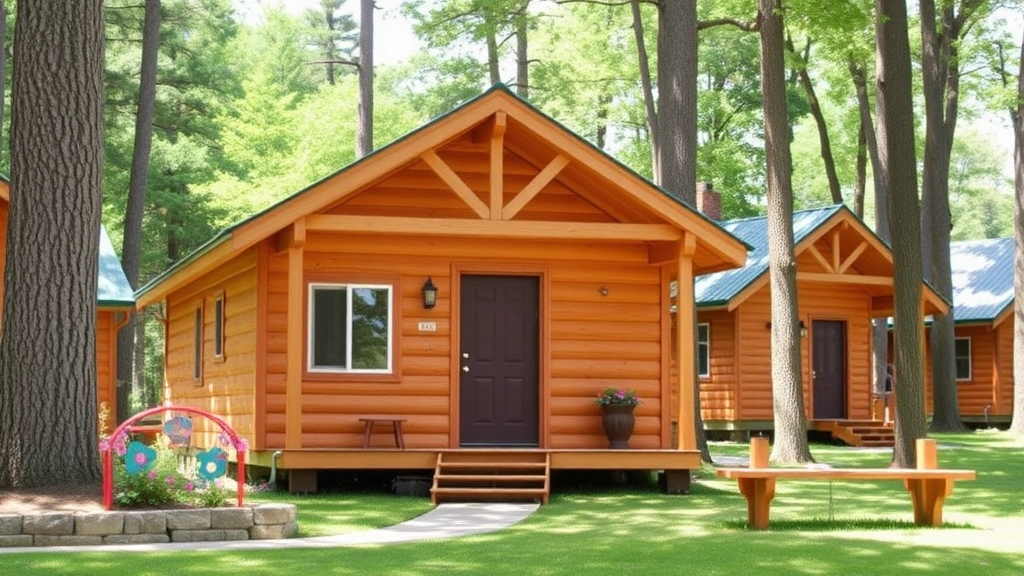
Alright, let’s get real for a second.
You’ve got kids in your camp, and their safety is your top priority, right?
So, what are the safety standards for summer camp cabins?
You don’t want to cut corners here.
Here’s the lowdown on what you need to know:
Fire Safety
First up, fire safety.
This is non-negotiable.
Every cabin needs:
- Smoke detectors: These should be installed in every room.
- Fire extinguishers: Place them in accessible locations.
- Emergency exits: Clearly marked and easy to access.
Structural Integrity
You don’t want a cabin falling apart, do you?
- Regular inspections: Check for any signs of wear and tear.
- Sturdy materials: Use high-quality wood or metal.
Pest Control
No one likes creepy crawlies.
- Regular pest control: Schedule this periodically.
- Proper waste disposal: Keeps the critters away.
Electrical Safety
Faulty wiring can be a nightmare.
- Certified electricians: Only use professionals for installations.
- Regular checks: Inspect all electrical outlets and appliances.
Health and Hygiene
Kids can get sick quickly.
- Clean water supply: Test it regularly.
- Sanitation facilities: Keep them clean and functional.
Weather Preparedness
Mother Nature can be unpredictable.
- Storm-proofing: Ensure cabins can withstand heavy rain and winds.
- Heating and cooling: Keep the temperature comfortable.
Case Study: Camp Sunshine
Let me tell you about Camp Sunshine.
They had a fire drill that saved lives.
Why?
Because they followed these standards to the letter.
They had smoke detectors, fire extinguishers, and clearly marked exits.
When a small fire broke out, everyone knew what to do.
No one was hurt.
Cost and Budget Considerations
Let’s face it, when it comes to building or renovating summer camp cabins, the first thing on everyone’s mind is the cost. How much is this going to set us back? And more importantly, how do we make sure that every penny spent is worth it? If you’re in the same boat, you’re not alone. The trick is to balance quality and budget without compromising on safety or comfort. Here’s how you can do it.
Understanding the Basics: What’s Included in the Cost?
Before we dive into the nitty-gritty, let’s break down what typically makes up the cost of a summer camp cabin:
- Materials: Wood, metal, concrete, and insulation.
- Labour: Skilled workers to construct the cabin.
- Amenities: Beds, lighting, heating, and cooling systems.
- Safety Features: Fire alarms, extinguishers, and first-aid kits.
- Maintenance: Ongoing costs for repairs and upkeep.
Budgeting Tips: Making the Most of Your Money
- Set Clear Priorities: Decide what’s non-negotiable. Is it the quality of materials, the safety features, or the amenities? Rank them in order of importance.
- Get Multiple Quotes: Don’t settle for the first contractor you find. Get at least three quotes to compare prices and services.
- DIY Where Possible: If you have skilled volunteers or staff, consider doing some of the work yourself. It can save you a significant amount of money.
- Opt for Durable Materials: Spending a bit more upfront on high-quality materials can save you money in the long run by reducing maintenance costs.
- Energy Efficiency: Invest in energy-efficient systems. They might cost more initially but will lower your utility bills over time.
Real-World Example: How One Camp Saved Big
Imagine you’re sitting down with a cup of coffee, and I tell you about Camp Evergreen. They were in a similar situation, needing to build new cabins but on a tight budget. What did they do? They followed these steps:
- They prioritised safety and opted for mid-range materials.
- They sourced local materials to cut down on transportation costs.
- They used volunteer labour for non-specialised tasks like painting and landscaping.
- They installed solar panels to reduce long-term energy costs.
By being smart about their choices, Camp Evergreen managed to build high-quality cabins without breaking the bank.
Hidden Costs: What to Watch Out For
- Permits and Inspections: Always factor these into your budget. Skipping them can lead to hefty fines.
- Unexpected Repairs: Always have a contingency fund for those “just in case” moments.
- Seasonal Maintenance: Budget for regular upkeep to avoid costly repairs down the line.
When it comes to summer camp cabins, the keyword is “investment.” Every pound spent should add value, whether it’s through enhanced safety, improved comfort, or reduced maintenance costs. By being strategic and smart about your spending, you can create a camp experience that’s both memorable and affordable.
Seasonal Maintenance Tips for Camp Cabins
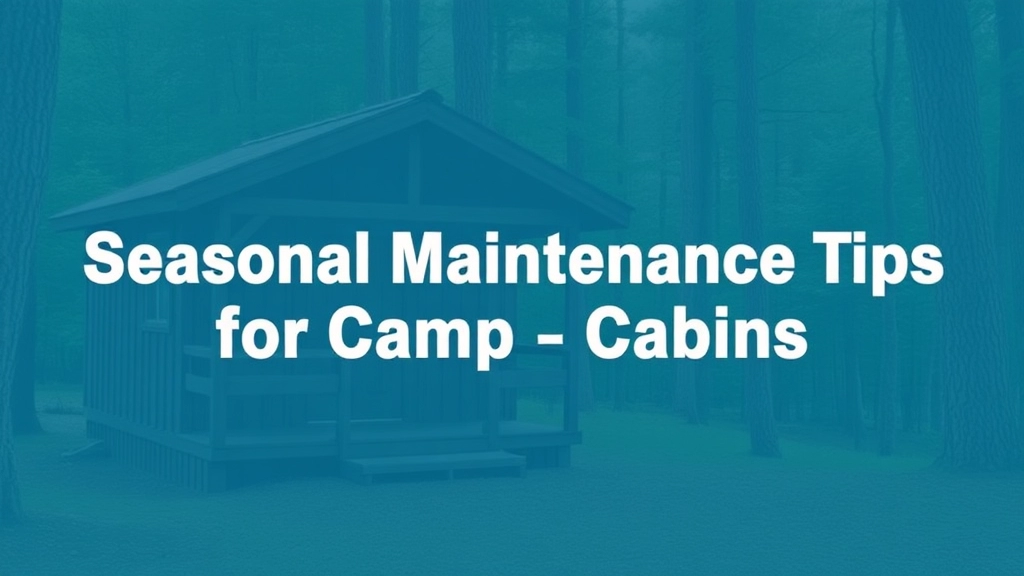
Worried about keeping your summer camp cabins in top shape all year round?
You’re not alone.
Seasonal maintenance can be a headache, but it’s crucial for a safe and comfy stay.
Let’s break it down.
Spring Cleaning: Fresh Start
Spring is the perfect time to shake off winter’s dust.
Here’s what you need to do:
- Inspect for Damage: Winter can be harsh. Check for any structural damage, like cracks or leaks.
- Deep Clean: Sweep, mop, and scrub every corner. Don’t forget those hidden spots.
- Pest Control: Winter guests might have moved in. Get rid of any pests before they become a problem.
Summer Prep: Ready for Action
Summer is peak season.
Make sure your cabins are ready:
- Check the Plumbing: Ensure all pipes and fixtures are working. No one wants a leaky tap.
- Test Electrical Systems: Lights, fans, and outlets should be in perfect condition.
- Stock Up: Have plenty of linens, toiletries, and first-aid supplies on hand.
Autumn Wrap-Up: Wind Down
As the season winds down, it’s time to prep for the colder months:
- Clean Gutters: Falling leaves can clog gutters, leading to water damage.
- Store Outdoor Furniture: Protect your furniture from the elements by storing it indoors.
- Seal Windows and Doors: Keep the cold out and the warmth in by sealing any gaps.
Winter Watch: Stay Safe
Even if your camp is closed, winter maintenance is key:
- Snow Removal: Regularly clear snow from roofs and walkways to prevent damage and accidents.
- Monitor Heating Systems: Ensure any heating systems are functioning properly to avoid freezing pipes.
- Security Check: Regularly check on the cabins to prevent break-ins or vandalism.
Quick Tips for Year-Round Maintenance
- Regular Inspections: Monthly checks can catch small issues before they become big problems.
- Keep a Log: Document all maintenance activities. This helps in tracking what’s been done and what’s due.
- Hire Professionals: Sometimes, it’s best to call in the experts for plumbing, electrical, or pest control issues.
Real-Life Example: Camp Evergreen
At Camp Evergreen, we follow these tips religiously.
Last spring, we found a tiny leak in one cabin.
Fixed it immediately.
Saved us from a massive water damage issue later.
Maintenance isn’t just a chore.
It’s an investment in your camp’s success.
So, roll up your sleeves and get to work.
Your campers will thank you.
And remember, a well-maintained cabin is a happy cabin.
How to Choose the Right Cabin for Your Camp
Choosing the right cabin for your summer camp can feel like a daunting task. You’re probably asking yourself, âWhat’s the best option for our needs?â or âHow do I ensure it’s both comfortable and cost-effective?â Let’s break it down into bite-sized pieces.
Understanding Your Camp’s Needs
First things first, get clear on what your camp really needs. Think about:
- Capacity: How many campers do you need to accommodate?
- Purpose: Is it for sleeping, activities, or both?
- Location: What’s the terrain like? Near a lake or deep in the woods?
These questions will guide your decision-making process.
Evaluating Different Cabin Types
There are various types of cabins, each with its own perks:
- Rustic Cabins: Basic, no-frills, great for that classic camp feel.
- Modern Cabins: Equipped with amenities, offering more comfort.
- Eco-Friendly Cabins: Sustainable and energy-efficient, ideal for nature-focused camps.
Key Features to Consider
When looking at cabin options, focus on these essential features:
- Durability: Can it withstand the elements?
- Insulation: Keeps it cool in summer, warm in winter.
- Ventilation: Proper airflow to keep it fresh.
Budgeting Wisely
Cost is always a factor, right? Here’s how to stay on track:
- Initial Costs: Consider both purchase and installation.
- Maintenance: Factor in long-term upkeep.
- Potential Upgrades: Plan for future improvements.
Safety Comes First
Safety isn’t just a checkbox; it’s a priority. Ensure your cabins meet all safety standards, like:
- Fire Safety: Smoke detectors and fire extinguishers.
- Structural Integrity: Regular inspections for wear and tear.
Real-Life Examples
Let’s talk about Camp Sunny Trails. They opted for eco-friendly cabins, saving 20% on energy costs while boosting camper satisfaction. Or take Camp Adventure, which chose modular cabins for easy expansion.
Making the Final Decision
Choosing the right cabin is about aligning with your camp’s mission and budget. Here’s a quick checklist:
- Match your needs: Does it fit your camp’s style and purpose?
- Stay within budget: Are you getting the best value?
- Prioritize safety: Is it a secure environment for campers?
For more insights on creating a safe and enjoyable camp experience, check out our Summer Camp Cabin Safety and Design Tips and Summer Camp Culture, Activities, and Traditions articles.
Case Studies of Successful Summer Camp Cabins
Ever wondered what makes a summer camp cabin truly successful?
Let’s break it down with some real-life examples.
Example 1: The Eco-Friendly Haven
First up, we have Camp Greenwoods. Their cabins are a dream for anyone who loves the environment. They’ve used sustainable materials like reclaimed wood and solar panels.
Here’s what makes them stand out:
- Solar-Powered Energy: Keeps the cabin running efficiently.
- Reclaimed Wood: Adds a rustic charm while being eco-friendly.
- Rainwater Harvesting Systems: Perfect for reducing water waste.
Campers rave about the natural feel and the positive impact on the environment.
Example 2: The Luxury Retreat
Next, let’s talk about Camp Comfort. These cabins are all about luxury. Think of them as glamping on steroids.
Key features include:
- Air Conditioning: Keeps everyone cool during those hot summer days.
- Private Bathrooms: No more communal showers.
- High-Quality Bedding: Ensures a good night’s sleep.
The feedback? Campers love the comfort and the little touches that make their stay special.
Example 3: The Adventure Hub
Last but not least, we have Camp Adventure. These cabins are designed for the thrill-seekers. They focus on functionality and durability.
Here’s what they offer:
- Sturdy Construction: Built to withstand the elements.
- Built-In Storage: Perfect for all your adventure gear.
- Proximity to Activities: Close to hiking trails, lakes, and climbing walls.
Campers appreciate the practical design that enhances their adventure experience.
What’s the Takeaway?
Whether it’s sustainability, luxury, or adventure, successful summer camp cabins cater to specific needs. They go beyond just providing a place to sleep. They enhance the overall camp experience.
Why Does This Matter?
Choosing the right cabin can make or break your camp. It’s not just about the structure but how it fits into the camp’s ethos and activities.
Your Turn
Think about what your campers need. Is it eco-friendly features, luxury amenities, or a base for adventure? Pick a cabin that aligns with your camp’s values and activities. Trust me, it makes all the difference.
Final Thoughts
Successful summer camp cabins aren’t just buildings. They’re an integral part of the camp experience. For more tips on setting up the perfect summer camp, check out our Summer Camp Cabin Bunk Safety and Design Tips. Also, if you’re looking for a comprehensive guide on summer camp activities, don’t miss our article on Summer Camp Activities: Fun and Learning Combined.
FAQs about Summer Camp Cabin Stock
What are the key features of a high-quality camp cabin?
A high-quality camp cabin should have durability and strength, comfort, safety, functionality and space, and aesthetic appeal. These features ensure that the cabin is not only long-lasting but also comfortable and safe for its occupants.
What materials are commonly used in building camp cabins?
Common materials include wood, metal, composite materials, and concrete. Each material has its own pros and cons, so the choice depends on factors like climate, budget, and desired aesthetic.
Why is durability important in camp cabins?
Durability is crucial because it ensures that the cabin can withstand harsh weather conditions and regular wear and tear. Materials like pressure-treated wood and metal roofing are often used for their strength and longevity.
What should I look for in terms of comfort in a camp cabin?
Comfort features include good insulation, proper ventilation, and comfortable bedding. These elements help maintain a pleasant temperature inside the cabin and ensure a good night’s sleep.
How can I ensure the safety of a camp cabin?
Safety can be ensured by installing smoke detectors, keeping fire extinguishers accessible, and ensuring sturdy construction with no loose floorboards or shaky railings. Regular inspections are also crucial.
What are some tips for maintaining camp cabins throughout the year?
Seasonal maintenance is key. For example, spring cleaning involves inspecting for damage and deep cleaning, while summer prep includes checking plumbing and electrical systems. Autumn wrap-up focuses on cleaning gutters and sealing windows, and winter watch involves snow removal and monitoring heating systems.
What are the pros and cons of using wood in camp cabins?
Pros: Wood is aesthetically pleasing and provides good insulation. Cons: It requires regular maintenance and can be prone to pests.
How can I make a small cabin feel more spacious?
A smart layout can make a small space feel bigger. Consider separate areas for sleeping, dressing, and lounging, and utilize storage solutions like under-bed storage and shelves.
What are some real-life examples of well-maintained camp cabins?
Camp Evergreen follows strict maintenance protocols, catching small issues like leaks early to prevent larger problems. Camp Sunshine is another example, where adherence to safety standards like fire drills has proven life-saving.
What should I consider when choosing materials for camp cabins?
Consider the climate, budget, longevity, and aesthetics. The right material can make a significant difference in comfort, durability, and overall cabin experience.

